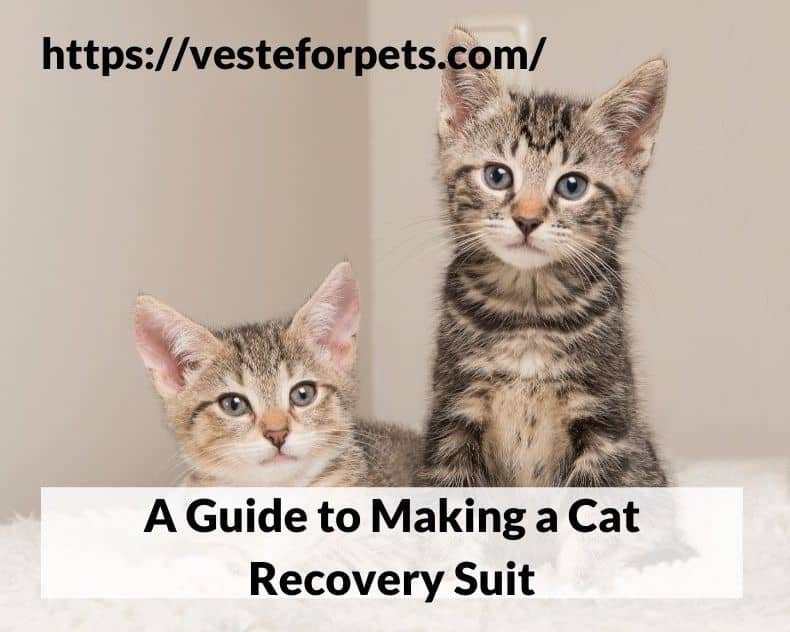After surgery, your cat will likely get a bit fed up with its stitches. It might start licking, scratching, or gnawing on them, which can have disastrous consequences like an infection or re-opening the incision entirely. It would be best to provide them a recovery suit to ensure they don’t harm themselves on accident.
It’s easy to make a cat recovery suit. You can make cat “panties” for covering up spay and neuter stitches, or craft a snug sock sweater to cover up surgical wounds and calm anxiety due to the relatively tight fit. You can also use an old shirt for an easy-to-wear full recovery suit. Lastly, for those uninterested in DIY, you can buy a baby onesie for your kitty.
No matter which you choose, prioritize your cat’s safety. Even though you’re using DIY methods, you should still aim for some level of precision. Leg holes that are too big can accidentally expose the stitches, defeating the purpose of the suit. On the other hand, a suit that’s too tight will just cause more problems. Here are the best methods for making your cat a recovery suit after surgery.
Use a Baby Onesie for Your Cat’s Recovery Suit
For some kitties, having a recovery suit after surgery is much better than a simple E-collar (short for “Elizabethan collar”). While both are designed to keep your kitty from scratching or biting at itself after the procedure, the recovery suit is a bit more dependable than the other. Plus, it’s much less cumbersome for the kitty to wear. (Source: Preventive Vet)
The easiest way to get a recovery suit on your cat is to repurpose a baby onesie. This way, you don’t have to craft anything or do any extra work. The only thing for you to do is measure your cat to ensure it can fit the clothing you purchase. The average cat should only weigh about 10lbs (of course, this varies by breed) and reach 8-10″ in height, while a full-term baby is 19-20″ long and 7+ lbs. (Source: WebMD; Healthline; Healthline)
Since the cat won’t fit the onesie perfectly, you may need to adjust one size up or down to make it fit perfectly. In some cases, you may need to tailor the outfit to your kitty’s body size. In any case, this is still much easier to do than making the cat recovery suit from scratch. Once you have the right size, you’ll need some pointers to get it onto your kitty. Here’s how to do it (Source: Dermatology for Animals):
- Take the part of the onesie that is supposed to hold the diaper and cut a small hole in it. It’s best to cut in the center, starting with a small slit.
- Pull the new cut apart to make it slightly larger. This is where your cat’s head is going to go since you will be putting the onesie on upside down. Try slipping it on and off your cat’s head to ensure it fits properly, if necessary.
- Scrunch up the onesie, so you are holding it securely in your hands, with the armholes facing downward.
- Put your arm through the onesie and hold your cat’s bum securely in your hand while slipping the clothing onto its body.
- Pull the onesie up over your cat’s bottom as far as comfortably possible, then work its legs into the armholes. At this point, your cat may struggle against you. This is normal, so don’t get too worried about it. Continue fitting the onesie on – the longer you take, the grumpier your cat is going to get.
- Your cat’s tail should now be through the head hole and its legs through the armholes. Now, work the onesie further up the body until it reaches the shoulders.
- Pull the hole you just cut over the cat’s head.
- Since the hole is at the bottom of the onesie, you can use the buttons to secure the clothing on your kitty’s body. Button it up, and your cat is ready to go.
Making Cat “Panties” for Post-Surgery Recovery
Some cat owners may not want to make a full recovery suit for their fur-babies. If you want to take a minimalist approach and clothe your cat only where it matters, then you might like the idea of making cat “panties” instead. This is great for cats that have just had a spay or neuter procedure, as it only covers up the nether regions without having to bother the rest of the body.
The most common issues to befall cats post-surgery (specifically spay and neuter operations) include inflammation, infection, fluid build-up, and bleeding. Some of these are simply the body’s natural reactions to the disturbance caused by the surgery. However, others are direct results of your cat messing with their stitches, either by licking, biting, or scratching. (Source: Massachusetts Society for the Prevention of Cruelty to Animals)
The best way to ensure they’re protected from such problems is to bar their access to the surgery site altogether. Here’s how to make cat “panties” to keep them as comfortable as possible post-surgery without any sewing at all (Source: Alterations by Phyllis):
- Choose an old t-shirt that you either don’t use anymore or that you don’t mind getting messy.
- (Optional.) If the t-shirt is small, you won’t need to cut it down to size. However, if it is a large t-shirt, place the fabric against your cat’s body to determine how large a rectangle you need to cut. You’ll need enough to wrap around your cat’s lower body and tie several ends together to secure it on the body. Leave at least four inches of excess material for tying knots.
- Once you have a correctly sized rectangle, cut out two large leg holes. Please be generous with your cuts – you want to leave enough room for your cat to move around freely without discomfort or pain. Just be careful that the holes aren’t excessive. Otherwise, you risk the incision being exposed by accident as the fabric shifts while your cat moves around.
- Now, it’s time to focus on the excess material. Cut at least three fastens on each side of the rectangle. These should be on either side of the leg holes. Again, these need to be at least four inches in length. However, it’s best to take a good look at your kitty and adjust the dimensions as necessary.
- Try it on your cat. Check if the fastens are long enough to tie together, and check if the leg holes are comfortable for your kitty. You don’t want to tie it on too tightly. However, it should be snug enough to stay on an energetic kitten or active adult cat. Once everything is suited to your individual cat’s body size, you’re all ready to go!
Making a Recovery Onesie for Your Cat
Not all surgeries are restricted to your cat’s bottom half. Some are far more extensive and require more coverage to ensure your cat’s health and safety. If this is the case for your fur-baby, you’ll need to veer away from the “panty” idea and go for a full onesie instead. However, instead of buying a onesie, as the first section suggests, you may find it more suitable to craft a custom suit for your cat.
Why would you make a onesie for your cat from scratch instead of buying a recovery suit? Well, for one, as mentioned earlier, cats come in all different shapes and sizes. While some are very slender and light, such as hairless breeds, others, like the Maine Coon, are very hefty and require far more fabric to encase all their fluff.
You might also want to consider how tightly you want the onesie to fit. This depends heavily on the type of surgery your cat received. For instance, invasive surgeries that require anesthesia, like mending fractures, could leave your cat quite anxious. The anesthesia’s effects may last between 24-48 hours, leaving your cat with strange personality changes like aggressiveness or grouchiness. (Source: HOPE Spay/Neuter Clinic, Inc.)
With all this considered, you might want to make a onesie similar to an anxiety jacket or a “thundershirt.” These apply gentle, constant pressure on your cat’s body, helping to reduce stress and anxiety. So, by making a relatively tight-fitting recovery suit, you could protect your cat’s incisions while helping them keep their stress levels down. Here’s how to do that. (Source: PetMD)
Sock Method: A Snug Recovery Suit for Cats
This is perhaps the best option for making a cat recovery suit that simultaneously covers up the incision site and manages your cat’s stress at the same time. This is because socks are naturally tight-fitting. Think about it: If it fits snugly over your foot, it’s going to give your kitty a nice, calming squeeze, too. Here are a few things you’re going to need for this project (Source: Helping Hand How-to):
- An old sock (It’s best to choose a sock that’s lost the other part of the pair or one you don’t wear anymore. Even old, stretched socks will work just fine.)
- Scissors
- Permanent marker
After you’ve gathered all these tools, it’s time to get crafting. Follow these steps below to make your cat a snug recovery suit for calmness and post-surgery healing:
- Cut off the bottom 1-1.5″ of fabric from the sock (this is just the toes). You’ll need both ends to be open, of course, so you cat can wear it correctly.
- Lay the sock on a flat surface and tuck in the heel’s fabric. This is the first step in preparing the armholes.
- Using the permanent marker, draw a half-circle on the fabric. A half-inch radius will do just fine at this stage. If you think it’s too small for your cat, grab a measuring tape and measure the diameter of its leg. Make sure your semi-circle is half that measurement since it’ll expand to the full diameter once unfolded.
- Cut off the top of the sock. The amount of fabric you cut off here will depend on your cat’s size. This part will be going over its neck. So, it would be best to measure the neck’s length to make sure they’ll be fully covered.
- Note: Here, you should also consider where on the cat’s body the surgery was performed. If there were incisions on the neck or perhaps behind the ears, then it may be a good idea to leave a good amount of the sock’s length here to cover it up.
- The sock recovery suit is now finished. If you need to make adjustments to its dimensions, try it on your cat. Remember, your cat will not be happy about its new outfit at first! Just speak gently while you’re fitting it and pet the kitty all the while.
- Note: Please remember to clip your cat’s claws before you attempt to fit it on your kitty. The last thing you want is to create more discomfort by getting the claws snagged in the fabric (or giving your cat the opportunity to accidentally scratch you or itself).
DIY T-shirt Method: How to Make a Cat Onesie from Scratch
There is one last alternative to making your cat a recovery suit that can either be tight-fitting or just loose enough for lots of movement. Like the “panty” item described above, you’ll need to use an old t-shirt for this project. You’ll only need scissors and an unwanted shirt to get started. When you’ve got those items, follow the instructions below (Source: EPBOT):
- Lay your t-shirt flat on the floor and “map” out where your cat’s head and legs are going to fit into it. Draw out the arms and legs and a neck hole if you choose to do so. Make sure to leave extra space on the sides of the shirt for cutting the straps.
- Note: A neck hole is optional. This DIY method’s creators found that neck straps worked far better than a neck hole since the latter stretched over time and ruined the suit’s fit. If your cat is likely to chew on the neckpiece (which happens if it’s too far down, near the shoulders), it’s best to opt out of a neck hole and go for the straps.
- (Optional.) There are two ways you can cut a neck hole if you choose to make one:
- You can simply cut a hole for the neck and avoid making any straps at all. This will likely lead to the hole stretching out, ultimately causing the whole outfit to slip lower on the body throughout the day. Still, this might work if your cat’s not too fidgety or active, or you expect only a short recovery period.
- You can also cut a neck hole with straps positioned in front of the neck hole. This secures the onesie around the neck while also ensuring it won’t slip down even if it stretches, thanks to the fastens. So, your cat might still chew on it, but it’ll remain secure. This works fine if there is something around the neck you want to cover up.
- Once you’ve chosen what design you want for the neck hole, you can complete the leg holes. It’s a good idea to stand your cat on top of the shirt and mark where all their legs are positioned relative to one another. This ensures that all parts are aligned correctly.
- Cut out the straps. According to the creators’ final “prototype,” the final recovery suit should have five straps on each side: one for the neck (if you’ve chosen that style), three for the abdomen, one for the backside. The last strap ensures that the whole suit won’t move around too much.
- (Optional.) You can cut out the neck-straps without having a neck hole at all. The creators found this to be the most secure method of all the alternatives. To do this, you’ll need to cut the top of the shirt off entirely, making the top of the neck strap the terminal end of the suit, with the bottom straps as the bottom.
- Now, it’s time for your kitty to try on their new recovery suit. This is the most effortless style to slip onto your cat. You simply stand your cat up (or have them lay on their back) and slip the suit onto their legs. Secure the straps on their neck and body as tightly as you think is necessary, and they should be safe and comfortable throughout the healing period.
In Conclusion
Making a cat recovery suit is easy, as long as you have a few extra clothes around the house to spare. There are four main methods you can choose to make your cat a comfortable suit, including:
- Buying a baby onesie
- Making cat “panties” (best for spay and neuter recovery periods)
- Sock recovery sweater
- Old t-shirt recovery suit
All of these have different advantages and drawbacks. For instance, the baby onesie is great for covering up sutures in easy-to-reach places nearly anywhere on the body, while the panties are excellent for spay or neuter recovery. Anxious cats would do best with a snug sock recovery sweater, and the DIY old t-shirt recovery suit is ideal for finicky cats that might chew on the neck of their suit.
Content Disclaimer
The information contained above is provided for information purposes only. The contents of this Blog article are not intended to amount to advice, and you should not rely on any of the contents of this Blog article. Professional advice should be obtained before taking or refraining from taking any action as a result of the contents of this Blog article. VesteForPets.com disclaims all liability and responsibility arising from any reliance placed on any of the contents of this Blog article.
Copyright Notice
These works are protected by copyright laws and treaties around the world. We grant to you a worldwide, non-exclusive, royalty-free, revocable licence to view these works, to copy and store these works and to print pages of these works for your own personal and non-commercial use. You may not reproduce in any format any part of the works without our prior written consent.
Copyright © 2022 – 2024 Veste For Pets







